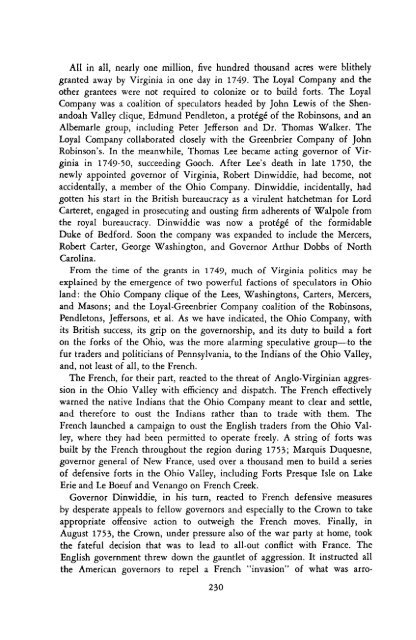Conceived in Liberty Volume 2 - Ludwig von Mises Institute
Conceived in Liberty Volume 2 - Ludwig von Mises Institute
Conceived in Liberty Volume 2 - Ludwig von Mises Institute
You also want an ePaper? Increase the reach of your titles
YUMPU automatically turns print PDFs into web optimized ePapers that Google loves.
All <strong>in</strong> all, nearly one million, five hundred thousand acres were blithely<br />
granted away by Virg<strong>in</strong>ia <strong>in</strong> one day <strong>in</strong> 1749. The Loyal Company and the<br />
other grantees were not required to colonize or to build forts. The Loyal<br />
Company was a coalition of speculators headed by John Lewis of the Shenandoah<br />
Valley clique, Edmund Pendleton, a protege of the Rob<strong>in</strong>sons, and an<br />
Albemarle group, <strong>in</strong>clud<strong>in</strong>g Peter Jefferson and Dr. Thomas Walker. The<br />
Loyal Company collaborated closely with the Greenbrier Company of John<br />
Rob<strong>in</strong>son's. In the meanwhile, Thomas Lee became act<strong>in</strong>g governor of Virg<strong>in</strong>ia<br />
<strong>in</strong> 1749-50, succeed<strong>in</strong>g Gooch. After Lee's death <strong>in</strong> late 1750, the<br />
newly appo<strong>in</strong>ted governor of Virg<strong>in</strong>ia, Robert D<strong>in</strong>widdie, had become, not<br />
accidentally, a member of the Ohio Company. D<strong>in</strong>widdie, <strong>in</strong>cidentally, had<br />
gotten his start <strong>in</strong> the British bureaucracy as a virulent hatchetman for Lord<br />
Carteret, engaged <strong>in</strong> prosecut<strong>in</strong>g and oust<strong>in</strong>g firm adherents of Walpole from<br />
the royal bureaucracy. D<strong>in</strong>widdie was now a protege of the formidable<br />
Duke of Bedford. Soon the company was expanded to <strong>in</strong>clude the Mercers,<br />
Robert Carter, George Wash<strong>in</strong>gton, and Governor Arthur Dobbs of North<br />
Carol<strong>in</strong>a.<br />
From the time of the grants <strong>in</strong> 1749, much of Virg<strong>in</strong>ia politics may be<br />
expla<strong>in</strong>ed by the emergence of two powerful factions of speculators <strong>in</strong> Ohio<br />
land: the Ohio Company clique of the Lees, Wash<strong>in</strong>gtons, Carters, Mercers,<br />
and Masons; and the Loyal-Greenbrier Company coalition of the Rob<strong>in</strong>sons,<br />
Pendletons, Jeffersons, et al. As we have <strong>in</strong>dicated, the Ohio Company, with<br />
its British success, its grip on the governorship, and its duty to build a fort<br />
on the forks of the Ohio, was the more alarm<strong>in</strong>g speculative group—to the<br />
fur traders and politicians of Pennsylvania, to the Indians of the Ohio Valley,<br />
and, not least of all, to the French.<br />
The French, for their part, reacted to the threat of Anglo-Virg<strong>in</strong>ian aggression<br />
<strong>in</strong> the Ohio Valley with efficiency and dispatch. The French effectively<br />
warned the native Indians that the Ohio Company meant to clear and settle,<br />
and therefore to oust the Indians rather than to trade with them. The<br />
French launched a campaign to oust the English traders from the Ohio Valley,<br />
where they had been permitted to operate freely. A str<strong>in</strong>g of forts was<br />
built by the French throughout the region dur<strong>in</strong>g 1753; Marquis Duquesne,<br />
governor general of New France, used over a thousand men to build a series<br />
of defensive forts <strong>in</strong> the Ohio Valley, <strong>in</strong>clud<strong>in</strong>g Forts Presque Isle on Lake<br />
Erie and Le Boeuf and Venango on French Creek.<br />
Governor D<strong>in</strong>widdie, <strong>in</strong> his turn, reacted to French defensive measures<br />
by desperate appeals to fellow governors and especially to the Crown to take<br />
appropriate offensive action to outweigh the French moves. F<strong>in</strong>ally, <strong>in</strong><br />
August 1753, the Crown, under pressure also of the war party at home, took<br />
the fateful decision that was to lead to all-out conflict with France. The<br />
English government threw down the gauntlet of aggression. It <strong>in</strong>structed all<br />
the American governors to repel a French "<strong>in</strong>vasion" of what was arro-<br />
230
















